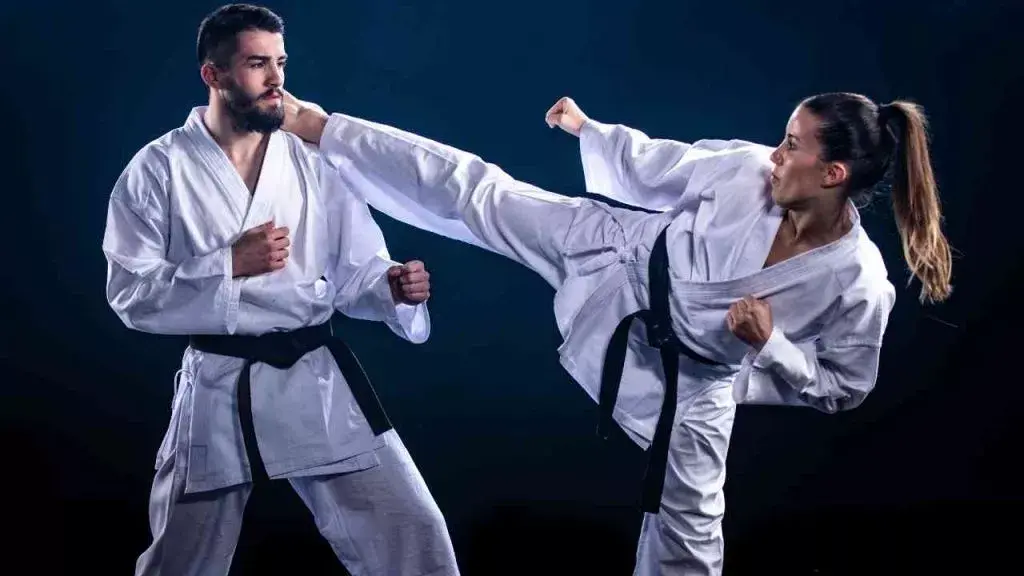Karate: The Art of Empty-Handed Combat: A martial art originating from Okinawa, Japan, is a discipline that combines physical prowess with mental fortitude. The term “karate” translates to “empty hand,” reflecting the art’s emphasis on unarmed combat. Developed in the early 20th century, karate has since evolved into a globally recognized sport and self-defense system, offering practitioners a pathway to physical fitness, self-discipline, and personal growth.
History of Karate
Karate’s roots can be traced back to the Ryukyu Kingdom, where indigenous fighting styles merged with Chinese martial arts brought by trade and cultural exchanges. In the early 1900s, Gichin Funakoshi, often regarded as the father of modern karate, introduced the art to mainland Japan. Funakoshi’s teachings emphasized not only combat techniques but also the philosophical aspects of karate, focusing on self-improvement and ethical behavior.
Principles and Philosophy
Karate is grounded in the principles of respect, humility, and perseverance. The practice is not just about learning to fight but about cultivating a balanced and disciplined mind. The dojo kun, or training hall rules, often recited at the beginning and end of each class, serve as a moral guide for practitioners, emphasizing values such as character, effort, etiquette, and self-control.
Techniques and Training
Karate training encompasses three main components: kihon (basics), kata (forms), and kumite (sparring).
Kihon
Kihon involves the practice of fundamental techniques, including strikes, kicks, blocks, and stances. This repetitive training develops muscle memory, strength, and precision, forming the foundation for more advanced movements.
Kata
Kata are predefined sequences of movements that simulate combat against multiple opponents. Each kata is a combination of offensive and defensive techniques, performed in a specific pattern. Practicing kata helps students understand the application of techniques and improves their coordination, balance, and concentration.
Kumite
Kumite, or sparring, allows practitioners to apply their skills in a controlled environment. It ranges from pre-arranged sparring drills to free-form fighting, where students can test their techniques against a live opponent. Kumite enhances reflexes, timing, and the ability to read an opponent’s intentions.
Benefits of Practicing Karate
Karate offers numerous physical, mental, and emotional benefits.
Physical Benefits
- Improved Fitness: Karate training provides a full-body workout, enhancing cardiovascular health, flexibility, and muscle strength.
- Weight Management: The intense physical activity helps burn calories and maintain a healthy weight.
- Coordination and Balance: Regular practice improves motor skills and body awareness.
Mental Benefits
- Focus and Concentration: Karate requires mental discipline, enhancing the ability to concentrate and stay focused.
- Stress Relief: Physical activity and the meditative aspects of training help reduce stress and anxiety.
- Self-Confidence: Mastering techniques and progressing through ranks boosts self-esteem and confidence.
Emotional Benefits
- Self-Discipline: The structured nature of karate promotes self-discipline and a strong work ethic.
- Respect for Others: The emphasis on etiquette fosters respect and humility.
- Perseverance: Overcoming challenges in training cultivates a resilient mindset.
Karate in the Modern World
Today, karate is practiced worldwide, with millions of enthusiasts training in dojos, community centers, and schools. It has become a popular sport, featured in international competitions such as the World Karate Championships and the Olympic Games. Beyond the competitive arena, karate is also valued for its practical self-defense applications and its role in personal development.
Different Styles of Karate
Karate has evolved into various styles, each with its own unique characteristics and philosophies. Some of the most prominent styles include:
- Shotokan: Founded by Gichin Funakoshi, Shotokan emphasizes long, deep stances and powerful linear techniques.
- Goju-Ryu: Known for its combination of hard and soft techniques, Goju-Ryu incorporates circular movements and breathing exercises.
- Shito-Ryu: This style blends elements from both Okinawan and Japanese martial arts, offering a diverse range of techniques.
- Wado-Ryu: Founded by Hironori Otsuka, Wado-Ryu focuses on body evasion and fluid movements, integrating jujitsu principles.
Conclusion
Karate is more than just a martial art; it is a way of life that promotes physical fitness, mental clarity, and ethical conduct. Whether practiced for self-defense, sport, or personal development, karate offers a pathway to a healthier and more balanced life. As practitioners continue to hone their skills and embrace the art’s philosophy, karate will remain a timeless discipline that inspires and empowers individuals worldwide.
For More Self Defense Guides, And Tips Please Visit Our Homepage.
